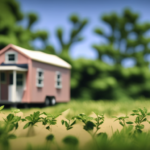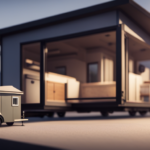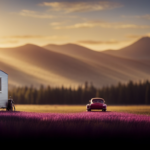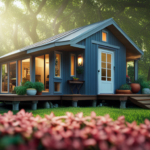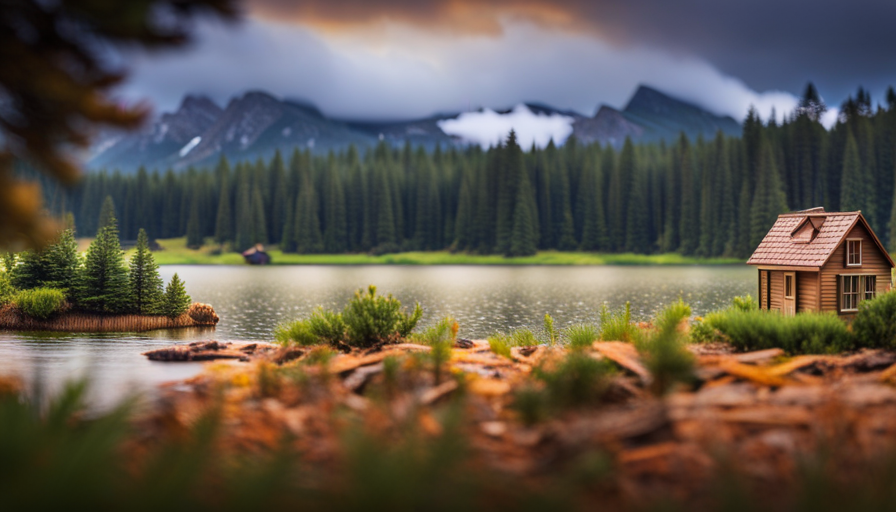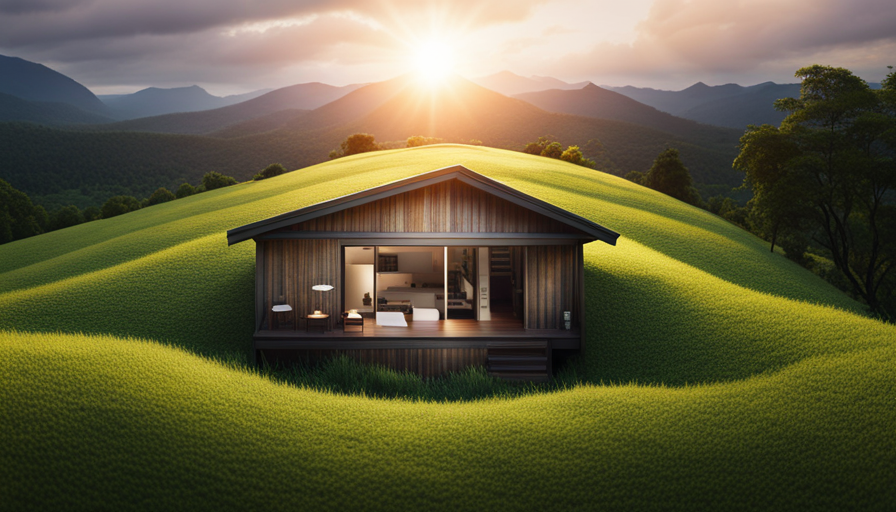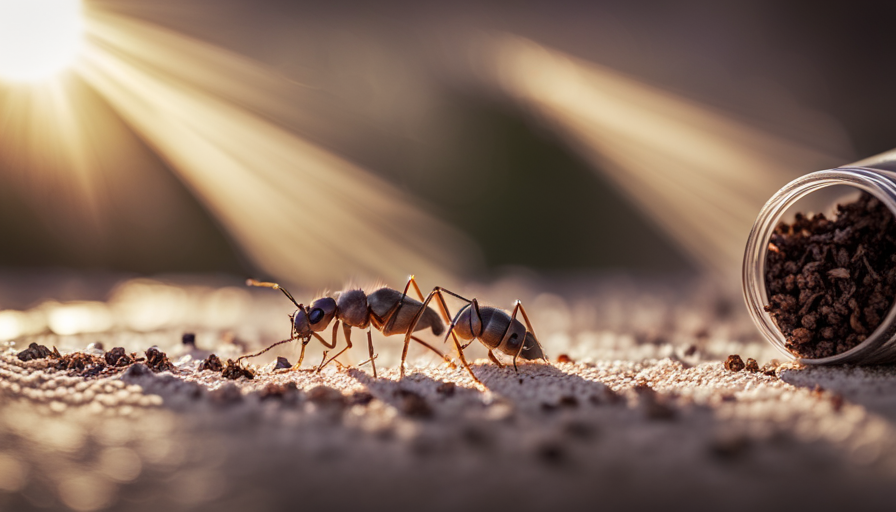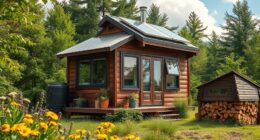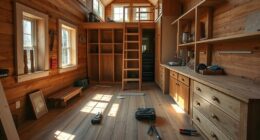Have you ever dreamed of living in a cozy and compact space that perfectly meets your needs? A tiny house might be the answer you’ve been looking for. But, there’s a crucial question: how big should your tiny house be?
As someone who has experienced the joys and challenges of living in a tiny house, I understand the importance of finding the right size for your unique lifestyle. In this article, I will guide you through the process of determining the ideal size for your tiny house. We will explore factors such as your lifestyle, available space, zoning regulations, and even future expansion possibilities.
By the end, you will have a clear understanding of how to create a space that is both functional and comfortable, maximizing every square inch. So, let’s dive in and discover how big to build your tiny house!
Key Takeaways
- Consider lifestyle, budget, and environmental impact when determining the size of your tiny house
- Familiarize yourself with building codes and zoning regulations to ensure compliance
- Maximize limited space with multi-functional furniture and storage solutions
- Plan for future expansion or modifications by incorporating modular components
Assess Your Lifestyle and Needs
Consider the lifestyle you want to have in your tiny house and let it guide you in determining the perfect size for your dream home. Assessing your budget is crucial in this process, as it’ll help you determine how much you can afford to spend on your tiny house. Evaluate your environmental impact as well, as building a smaller home can have a positive effect on the environment by reducing your carbon footprint.
When assessing your lifestyle and needs, think about how you’ll use the space in your tiny house. Will you be working from home and need a dedicated office area? Do you enjoy cooking and entertaining, requiring a larger kitchen and dining space? Are you someone who values a comfortable living area for relaxation? These questions will help you determine the square footage you need for each area of your tiny house.
Additionally, consider your future plans. Are you planning to live alone or with a partner? Do you anticipate any changes in your lifestyle, such as starting a family? Thinking ahead will ensure that your tiny house can accommodate your evolving needs.
Now that you’ve assessed your lifestyle and needs, it’s time to determine the available space and zoning regulations for your tiny house.
Determine Available Space and Zoning Regulations
Taking into account the available space and zoning regulations, it’s crucial to determine the size of your compact abode. Before you start envisioning the perfect layout and design, it’s important to assess the limitations imposed by the available space.
Consider the dimensions and shape of the plot of land where your tiny house will be situated. Are there any restrictions on the maximum size or height of the structure? Additionally, take into account any setbacks or easements that may limit the buildable area. Understanding these available space limitations will help you make informed decisions about the size and layout of your tiny house.
In addition to available space, it’s essential to familiarize yourself with the local building codes and zoning regulations. These regulations vary from one jurisdiction to another and can have a significant impact on the size of your tiny house. Some areas may have minimum square footage requirements, while others may place limits on the overall height or number of stories allowed. By researching and understanding these regulations, you can ensure that your tiny house complies with all necessary requirements.
Considering the available space and zoning regulations will provide you with a solid foundation for determining the appropriate size of your tiny house. Once you have a clear understanding of these factors, you can move on to the next step and consider the mobility and portability of your compact living space.
Consider Mobility and Portability
To ensure a sophisticated level of design, it is imperative that you contemplate the mobility and portability of your compact dwelling. When it comes to tiny houses, one of the key advantages is their ability to be mobile. Whether you want to travel the country or simply have the flexibility to move your house from one location to another, considering mobility is essential.
When designing a tiny house with mobility in mind, there are several transportation considerations to keep in mind. First, you need to think about the weight and size of your house. It should be lightweight enough to be towed by a vehicle, and compact enough to navigate through narrow roads or tight spaces. Additionally, you should consider the height and width restrictions imposed by transportation regulations in your area.
To help you visualize the importance of mobility and portability, here is a table showcasing the benefits and challenges of mobile living:
| Benefits | Challenges |
|---|---|
| Flexibility | Limited space |
| Freedom to travel | Finding parking |
| Minimalist lifestyle | Weather conditions |
| Cost savings | Limited amenities |
| Environmental impact | Maintenance |
Considering these factors will help you determine the appropriate size and design of your tiny house. In the next section, we will discuss how to plan for essential areas such as the kitchen, bathroom, sleeping, and living spaces, ensuring a functional and comfortable living environment.
Plan for Essential Areas: Kitchen, Bathroom, Sleeping, Living
When planning for essential areas in your compact dwelling, it’s crucial to carefully strategize the layout and functionality of the kitchen, bathroom, sleeping, and living spaces.
Designing the layout of these areas is key to maximizing the limited space available in a tiny house. Every square inch counts, so it’s important to make thoughtful choices when it comes to the placement of appliances, furniture, and storage solutions.
In the kitchen, consider using multi-functional appliances and compact storage options to save space. Installing a foldable dining table or utilizing a kitchen island with built-in storage can also help maximize the functionality of the area.
The bathroom should be designed to accommodate essential fixtures like a toilet, shower, and sink, while also incorporating storage solutions such as shelves or cabinets.
For the sleeping area, consider loft-style beds to free up valuable floor space. Incorporate built-in storage underneath or around the bed to maximize storage options.
When it comes to the living area, choose furniture that can serve multiple purposes, such as a sofa with hidden storage compartments or a coffee table that doubles as a desk.
By carefully designing the layout and maximizing space in the kitchen, bathroom, sleeping, and living areas, you can create a functional and comfortable tiny house.
Next, we’ll explore how to optimize storage solutions in your compact dwelling.
Optimize Storage Solutions
To truly maximize the functionality of your compact dwelling, optimizing storage solutions is essential. In a tiny house, every square inch counts, so it’s crucial to make the most of the available space. Here are some space-saving hacks and creative organization ideas to help you make the most of your storage:
- Utilize vertical space: Install tall bookshelves or cabinets that reach the ceiling to maximize storage without taking up valuable floor space.
- Use multi-purpose furniture: Invest in furniture pieces that serve multiple functions, such as a bed with built-in storage drawers or a coffee table with hidden compartments.
- Think outside the box: Look for unconventional storage solutions, such as hanging pots and pans from a ceiling rack or using a pegboard to hang tools and utensils.
- Maximize underutilized areas: Take advantage of unused spaces, like the area under the stairs or above the bathroom door, by installing shelves or cabinets.
By implementing these storage solutions, you can create a well-organized and clutter-free tiny house. With optimized storage, you can now prioritize comfort and functionality in other areas, such as designing a cozy living space or a comfortable sleeping area.
Prioritize Comfort and Functionality
Creating a space that is both comfortable and functional is key to transforming your compact dwelling into a cozy and efficient home. When designing a tiny house, there are several important design considerations to keep in mind to prioritize comfort and functionality.
One of the main challenges in a small space is utilizing every inch effectively. Maximizing space utilization is crucial to ensure that you have enough room for all your belongings and activities.
To optimize comfort and functionality, it’s essential to carefully plan the layout of your tiny house. Consider the flow of the space and how you can make the most of each area. For example, placing the kitchen near the entrance can minimize the distance traveled when bringing groceries inside. Additionally, incorporating storage solutions that are easily accessible and well-organized will help keep your tiny house clutter-free.
In terms of design, opting for multi-purpose furniture and design elements is a smart choice. Look for furniture pieces that can serve multiple functions, such as a sofa that can also be used as a guest bed or storage ottomans that double as seating. This will allow you to make the most of limited square footage while still ensuring comfort and practicality.
By prioritizing comfort and functionality through thoughtful design considerations and space utilization, you can create a tiny house that feels spacious and efficient. Incorporating multi-purpose furniture and design elements is just one step towards achieving this goal.
Incorporate Multi-Purpose Furniture and Design Elements
Consider incorporating furniture and design elements that can serve multiple functions, allowing you to make the most of your limited space while still ensuring comfort and practicality. Here are some multi-functional furniture and space-saving design ideas to help you maximize your tiny house:
-
Convertible sofa-bed: Invest in a sofa that can transform into a bed, providing a comfortable seating area during the day and a cozy sleeping space at night.
-
Foldable dining table: Opt for a dining table that can be folded down when not in use, freeing up valuable floor space for other activities.
-
Storage ottomans: Use ottomans that double as storage units, providing a place to rest your feet while also offering a hidden space to store items like blankets or books.
-
Wall-mounted drop-leaf desk: Install a wall-mounted desk that can be folded up when not needed, creating a functional workspace without taking up valuable floor space.
By incorporating these multi-functional furniture pieces and space-saving design ideas, you can create a comfortable and practical living space in your tiny house. Thinking about future expansion or modifications, you can easily adapt your layout to meet your changing needs without sacrificing comfort or functionality.
Think About Future Expansion or Modifications
When thinking about the future of your tiny living space, it’s important to envision potential expansions or modifications that can enhance your living experience. One of the great advantages of a tiny house is its long term adaptability. While you may have designed your tiny house to perfectly suit your current needs, it’s crucial to consider how your living situation might change over time.
By incorporating future expansion possibilities into your initial design, you can ensure that your tiny house will continue to meet your needs as they evolve.
There are several ways to plan for future expansion in your tiny house. One option is to design your house on a foundation that allows for additional rooms or levels to be added in the future. This way, you can easily expand your living space as your family grows or your needs change. Another option is to incorporate modular components into your design, such as removable walls or furniture that can be rearranged or added to as needed.
By thinking ahead and considering potential modifications or expansions, you can create a tiny house that will adapt to your changing needs over time.
In the next section, we will explore how seeking inspiration and ideas from existing tiny house designs can help you in the design process.
Seek Inspiration and Ideas from Existing Tiny House Designs
To gain inspiration and ideas for your tiny living space, you can seek out existing designs of compact dwellings. Tiny house design trends are constantly evolving, and by exploring different designs, you can discover innovative ways to make the most of your limited space. Creative space utilization is key when it comes to tiny house living, and studying existing designs can provide you with valuable insights.
Here are four examples of tiny house designs that showcase unique and efficient use of space:
-
Lofted sleeping areas: Many tiny houses incorporate lofted sleeping areas to maximize floor space. This allows for a separate sleeping area while still leaving room for other activities.
-
Foldable furniture: Cleverly designed furniture that can be folded and stowed away when not in use is a popular choice in tiny house designs. This allows for multi-functional spaces that can adapt to different needs throughout the day.
-
Built-in storage solutions: Tiny houses often feature built-in storage solutions that utilize every nook and cranny. From hidden compartments to floor-to-ceiling shelving, these designs prioritize efficient storage to keep your space clutter-free.
-
Outdoor living spaces: Some tiny house designs incorporate outdoor living spaces, such as decks or patios, to extend the usable area. These outdoor spaces can serve as a gathering area or an extension of the living space during good weather.
By exploring existing designs and incorporating elements that resonate with you, you can create a unique tiny house that suits your specific needs and preferences. However, it’s important to consult with professionals and builders for expert advice on how to bring your vision to life.
Consult with Professionals and Builders for Expert Advice
After seeking inspiration and ideas from existing tiny house designs, I realized that I needed some professional guidance to ensure that my own tiny house would be built to the right scale. With so many factors to consider, such as size, layout, and functionality, consulting with professionals and builders became essential in my decision-making process.
The benefits of seeking consultation are numerous. Professionals have extensive experience in the field and can provide valuable insights into the dos and don’ts of tiny house construction. They can offer advice on the optimal size for my specific needs, taking into account factors like available land, zoning regulations, and mobility requirements.
Consulting with professionals also allows me to tap into their vast network of resources and connections. They can recommend reputable builders who specialize in tiny house construction, ensuring that the project is executed with the highest level of expertise and craftsmanship.
Furthermore, professionals can assist in navigating the complexities of permits and regulations, ensuring that my tiny house meets all legal requirements. Their knowledge and expertise can save me from potential headaches and costly mistakes.
Overall, consulting with professionals and builders will provide me with the expert advice and guidance necessary to make informed decisions about the size and design of my tiny house.
Frequently Asked Questions
How much does it cost to build a tiny house?
When it comes to cost estimation for building a tiny house, budget planning is key. Factors such as materials, labor, and location all contribute to the overall cost. It’s important to research and gather quotes from suppliers and contractors to get an accurate estimate.
Additionally, considering any additional expenses like permits and utilities is essential. By carefully planning and budgeting, you can ensure that the cost of building your tiny house aligns with your financial goals and expectations.
What are the common challenges faced when living in a tiny house?
Living in a tiny house presents several challenges, mainly centered around space management and dealing with limited storage. As someone who’s experienced it firsthand, I can attest to the importance of efficient organization and creative solutions.
From maximizing vertical space with shelves and hooks to utilizing multipurpose furniture, every inch counts. It requires careful planning and constant decluttering, but with the right mindset and strategies, living in a tiny house can be a rewarding and fulfilling experience.
Are there any specific building codes and regulations for tiny houses?
Yes, there are specific building codes, regulations, zoning restrictions, and legal requirements that apply to tiny houses. These vary by location, so it’s important to research and understand the rules in your area.
Some common regulations include size limitations, minimum ceiling heights, and requirements for utilities and safety features. It’s crucial to comply with these guidelines to ensure your tiny house is legal and safe to live in.
How can I maximize energy efficiency in a tiny house?
To maximize energy efficiency in a tiny house, I focus on an energy-efficient design and sustainable materials.
Starting with the design, I prioritize insulation to minimize heat loss and gain. I also incorporate natural lighting and ventilation to reduce the need for artificial lighting and cooling.
As for materials, I opt for eco-friendly options like reclaimed wood, recycled insulation, and energy-efficient appliances.
It’s all about creating a sustainable living space without compromising comfort or style.
What are the financing options available for building a tiny house?
There are several financing options available for building a tiny house. One option is to explore tiny house loan options, which are specifically designed for financing the construction of tiny homes. These loans typically have favorable terms and can help cover the costs of materials, labor, and other expenses.
Another option is crowdfunding, where you can create a campaign and seek financial support from individuals or groups interested in your tiny house project. This can be a great way to raise funds and connect with a community of like-minded individuals.
Conclusion
In conclusion, determining the size of your tiny house is a personal decision that should be based on your lifestyle and needs. However, it’s interesting to note that according to a survey conducted by The Tiny Life, 68% of tiny house owners reported having more disposable income after downsizing.
This statistic highlights the financial benefits of living in a smaller space and can serve as motivation for those considering the tiny house lifestyle.
Remember to carefully plan and consult with professionals to ensure your tiny house meets your requirements and provides a comfortable living space.
Hi, I’m Emma. I’m the Editor in Chief of Tiny House 43, a blog all about tiny houses. While tree houses are often associated with childhood, they can be the perfect adult retreat. They offer a cozy space to relax and unwind, surrounded by nature. And since they’re typically built on stilts or raised platforms, they offer stunning views that traditional homes simply can’t match. If you’re looking for a unique and romantic getaway, a tree house tiny house might just be the perfect option.



